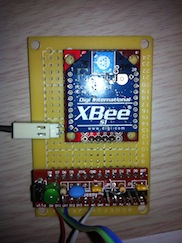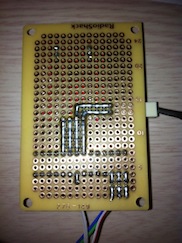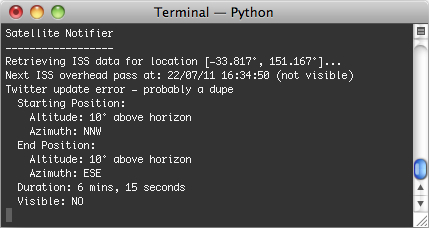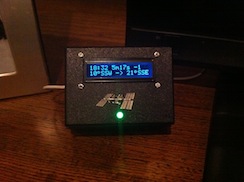Sat-Notifier is a little DIY satellite tracking project I've completed. It consists of 2 pieces. Firstly, a Python controller app running on my Mac that determines when a particular satellite will next be passing overhead my location, and whether that pass will be visible to the naked eye (this depends on the position of sun relative to the satellite, and also whether it's day time when the pass occurs). It transmits this information via XBee radios to a microcontroller which then displays details of the upcoming pass on an LCD display, and also uses an RGB LED to signify upcoming events in ways only an RGB LED can.
The Sat-Notifier controller app can be configured in a number of ways:
- it can monitor any satellite that is currently listed on Heavens-Above (this is where Sat-Notifier scrapes its information from).
- it can post to Twitter letting others know when your choice of satellite is overhead.
- it can post to Pachube to graph passes over time, although due to the averaging over time it's not exactly useful.
[HeavensAbove]
latitude: -33.8170
longitude: 151.1670
altitude: 80
timezone: AEST
satellite_id: 25544
satellite_name: "ISS"
hash_tag: ISS
This way I can easily change the app to monitor, say, the Hubble Space Telescope (HST) by quickly changing a couple of lines in the above file.


Connection ATmega328 Connection
+-----\/----+
Reset 1| PC6 PC5 |28 SCL
Rx 2| PD0 PC4 |27 SDA
Tx 3| PD1 PC3 |26
4| PD2 PC2 |25
XBee Tx 5| PD3 PC1 |24 LCD_E
XBee Rx 6| PD4 PC0 |23 LCD_RS
7| VCC GND |22
8| GND AREF |21
Xtal 9| PB6 AVCC |20
Xtal 10| PB7 PB5 |19
LCD_D7 11| PD5 PB4 |18
LCD_D6 12| PD6 PB3 |17 RGB_BLUE
LCD_D5 13| PD7 PB2 |16 RGB_GREEN
LCD_D4 14| PB0 PB1 |15 RGB_RED
+-----------+








Why buy stuff off the shelf when you can build it yourself - and learn something along the way! This has been a fun project - next project will involve some old skool Nixie tubes (circa 1970). Watch this space.
